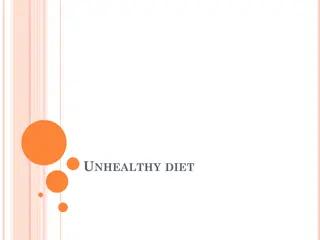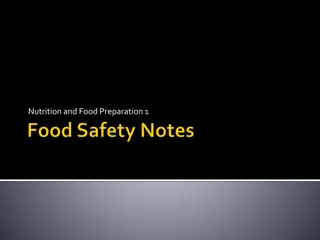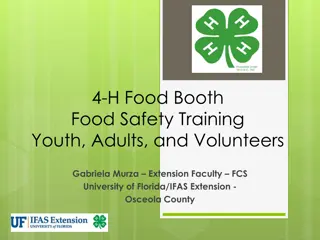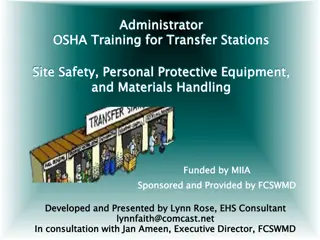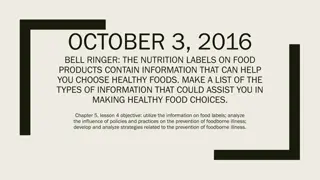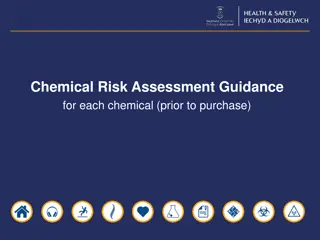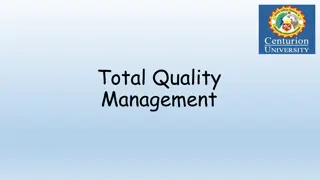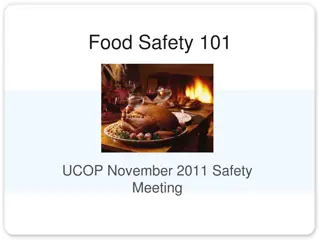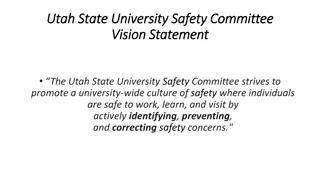Food Grade Chemical Handling Safety Information
Handling food-grade chemicals for flavor preparation requires minimal risk with proper precautions. The chemicals include 2,3-Pentanedione and Vanillin, commonly used in food products. Safety measures such as using a fume cupboard, wearing PPE, and proper disposal methods are recommended to ensure safe handling. Both chemicals pose very little risk when handled correctly. Refer to safety sheets for detailed safety instructions.
Uploaded on Sep 13, 2024 | 0 Views
Download Presentation

Please find below an Image/Link to download the presentation.
The content on the website is provided AS IS for your information and personal use only. It may not be sold, licensed, or shared on other websites without obtaining consent from the author. Download presentation by click this link. If you encounter any issues during the download, it is possible that the publisher has removed the file from their server.
E N D
Presentation Transcript
SAFETY INFORMATION There is inherently very little risk associated with handling very small quantities of these chemicals. All samples are used on a regular basis to prepare flavourings for incorporation into many food products. They are all food grade and have not been handled in a chemistry or microbiology lab. We recommend that they are dispensed in a fume cupboard if there is one available, otherwise use a well-ventilated room. We recommend that you wear PPE whilst dispensing (labcoat and safety goggles) as very occasionally there are skin sensitivities. We recommend that you store in a spark-proofed fridge. They contents can be disposed of down the sink, flushed with plenty of water and the eppendorfs and used smelling strips should be sealed in an empty water bottle or ziplock bag prior to disposal as the smell can linger. 1
2,3-Pentanedione safety sheet 2,3-Pentanedione Name of chemical, formulation CAS MSDS Hazard statements 2,3-pentanedione, acetylpropionyl 600-14-6 https://www.sigmaaldrich.com/GB/en/product/aldrich/241962 H225 Highly flammable liquid and vapor. H317 May cause an allergic skin reaction. H373 May cause damage to organs through prolonged or repeated exposure. Generally recognized as safe (FEMA GRAS 2841) by United States Food and Drug Administration (FDA) under the conditions of its intended use (i.e. added to food as part of a flavouring) 19 C <0.5 mL provided in vial, poses very little risk, transfer pipette provided to transfer 2-3 drops (~0.1 mL) to 20 mL ethanolic solution (~0.5% v/v). This chemical is routinely used as part of flavourings prepared for everyday human consumption. Keep lid tightly closed, inside another container in a cool, ventilated area if possible. Ensure no sources of ignition. Avoid inhalation of neat solution. Prepare in fume cupboard if possible or well- ventilated room. Avoid contact with skin. Wearing of gloves advised. Solution may be poured down the sink with plenty of water Flashpoint Quantity/concentration plus associated risk Storage Control- fume cupboard, gloves etc Disposal Managing risks and what to do in an emergency Risk Rinse affected area If the neat solution is handled properly by a teacher, there is very little risk associated with this chemical. If the ethanolic solution is spilt, rinse affected area, smell may linger
Vanillin safety sheet Vanillin Name of chemical, formulation CAS MSDS Hazard statements 4-Hydroxy-3-methoxybenzaldehyde 121-33-5 https://www.sigmaaldrich.com/GB/en/sds/sial/v1104 H319 Causes serious eye irritation Generally recognized as safe (FEMA GRAS 3107) by United States Food and Drug Administration (FDA) under the conditions of its intended use (i.e. added to food as part of a flavouring) 160 C <0.1g provided in vial poses very little risk, This chemical is routinely used as part of flavourings prepared for everyday human consumption. Keep lid tightly closed, inside another container in a cool, ventilated area if possible. Avoid inhalation of neat solution. Prepare in fume cupboard if possible or well- ventilated room. Avoid contact with skin. Wearing of gloves advised. Solution may be poured down the sink with plenty of water Flashpoint Quantity/concentration plus associated risk Storage Control- fume cupboard, gloves etc Disposal Managing risks and what to do in an emergency Risk Rinse affected area If the powder is handled properly by a teacher, there is very little risk associated with this chemical. If the ethanolic solution is spilt, rinse affected area, smell may linger.
Phenylacetaldehyde safety sheet 2-Phenylacetaldehyde Name of chemical, formulation CAS MSDS Hazard statements phenylacetaldehyde 122-78-1 https://www.sigmaaldrich.com/GB/en/sds/aldrich/w287407 H302 Harmful if swallowed. H314 Causes severe skin burns and eye damage. H317 May cause an allergic skin reaction. H412 Harmful to aquatic life with long lasting effects. Generally recognized as safe (FEMA GRAS 2858) by United States Food and Drug Administration (FDA) under the conditions of its intended use (i.e. added to food as part of a flavouring) 68 C <0.5 mL provided in vial, poses very little risk, transfer pipette provided to transfer 2-3 drops (~0.1 mL) to 20 mL ethanolic solution (~0.5% v/v). This chemical is routinely used as part of flavourings prepared for everyday human consumption. Keep lid tightly closed, inside another container in a cool, ventilated area if possible. Avoid inhalation of neat solution. Prepare in fume cupboard if possible or well- ventilated room. Avoid contact with skin. Wearing of gloves advised. Solution may be poured down the sink with plenty of water Flashpoint Quantity/concentration plus associated risk Storage Control- fume cupboard, gloves etc Disposal Managing risks and what to do in an emergency Risk Rinse affected area If the neat solution is handled properly by a teacher, there is very little risk associated with this chemical. If the ethanolic solution is spilt, rinse affected area, smell may linger
Furaneol safety sheet Furaneol Name of chemical, formulation CAS MSDS Hazard statements furaneol, 4-hydroxy-2,5-dimethyl-3(2H)-furanone 3658-77-3 https://www.sigmaaldrich.com/GB/en/sds/aldrich/w317403 H302 Harmful if swallowed. H314 Causes severe skin burns and eye damage. H317 May cause an allergic skin reaction. H318 Causes serious eye damage. Generally recognized as safe (FEMA GRAS 3174) by United States Food and Drug Administration (FDA) under the conditions of its intended use (i.e. added to food as part of a flavouring) n/a <0.5 mL provided in vial, poses very little risk, transfer pipette provided to transfer 2-3 drops (~0.1 mL) to 20 mL ethanolic solution (~0.5% v/v). This chemical is routinely used as part of flavourings prepared for everyday human consumption. Keep lid tightly closed, inside another container in a cool, ventilated area if possible. Avoid inhalation of neat solution. Prepare in fume cupboard if possible or well- ventilated room. Avoid contact with skin. Wearing of gloves advised. Solution may be poured down the sink with plenty of water Flashpoint Quantity/concentration plus associated risk Storage Control- fume cupboard, gloves etc Disposal Managing risks and what to do in an emergency Risk Rinse affected area If the neat solution is handled properly by a teacher, there is very little risk associated with this chemical. If the ethanolic solution is spilt, rinse affected area, smell may linger
-Decalactone safety sheet d-Decalactone Name of chemical, formulation CAS MSDS Hazard statements d-decalactone, ( )-5-decanolide 705-86-2 https://www.sigmaaldrich.com/GB/en/sds/sial/74026 No hazards. Generally recognized as safe (FEMA GRAS 2361) by United States Food and Drug Administration (FDA) under the conditions of its intended use (i.e. added to food as part of a flavouring) >113 C <0.5 mL provided in vial, poses very little risk, transfer pipette provided to transfer 2-3 drops (~0.1 mL) to 20 mL ethanolic solution (~0.5% v/v). This chemical is routinely used as part of flavourings prepared for everyday human consumption. Keep lid tightly closed, inside another container in a cool, ventilated area if possible. Avoid inhalation of neat solution. Prepare in fume cupboard if possible or well- ventilated room. Avoid contact with skin. Wearing of gloves advised. Solution may be poured down the sink with plenty of water Flashpoint Quantity/concentration plus associated risk Storage Control- fume cupboard, gloves etc Disposal Managing risks and what to do in an emergency Risk Rinse affected area If the neat solution is handled properly by a teacher, there is very little risk associated with this chemical. If the ethanolic solution is spilt, rinse affected area, smell may linger
3-Methylbutanoic acid safety sheet 3-Methylbutanoic acid Name of chemical, formulation CAS MSDS Hazard statements 3-methylbutanoic acid, isovaleric acid 503-74-2 https://www.sigmaaldrich.com/GB/en/sds/aldrich/129542 H314 Causes severe skin burns and eye damage. H318 Causes serious eye damage. Generally recognized as safe (FEMA GRAS 3102) by United States Food and Drug Administration (FDA) under the conditions of its intended use (i.e. added to food as part of a flavouring) 80 C <0.5 mL provided in vial, poses very little risk, transfer pipette provided to transfer 2-3 drops (~0.1 mL) to 20 mL ethanolic solution (~0.5% v/v). This chemical is routinely used as part of flavourings prepared for everyday human consumption. Keep lid tightly closed, inside another container in a cool, ventilated area if possible. Avoid inhalation of neat solution. Prepare in fume cupboard if possible or well- ventilated room. Avoid contact with skin. Wearing of gloves advised. Solution may be poured down the sink with plenty of water Flashpoint Quantity/concentration plus associated risk Storage Control- fume cupboard, gloves etc Disposal Managing risks and what to do in an emergency Risk Rinse affected area If the neat solution is handled properly by a teacher, there is very little risk associated with this chemical. If the ethanolic solution is spilt, rinse affected area, smell may linger







